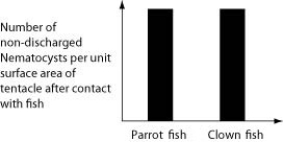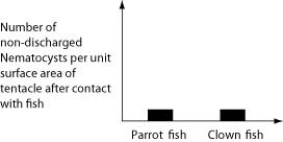Multiple Choice
Use the following information to answer the question.
An elementary school science teacher decided to liven up the classroom with a saltwater aquarium. Knowing that saltwater aquaria can be quite a hassle, the teacher proceeded stepwise. First, the teacher conditioned the water. Next, the teacher decided to stock the tank with various marine invertebrates, including a polychaete, a siliceous sponge, several bivalves, a shrimp, several sea anemones of different types, a colonial hydra, a few coral species, an ectoproct, a sea star, and several herbivorous gastropod varieties. Lastly, she added some vertebrates-a parrot fish and a clown fish. She arranged for daily feedings of copepods and feeder fish.
Normally, the clown fish readily swims among the tentacles of the sea anemones; the parrot fish avoids them. One hypothesis for the clown fish's apparent immunity is that they slowly build a tolerance to the sea anemone's toxin. A second hypothesis is that a chemical in the mucus that coats the clown fish prevents the nematocysts from being triggered. Which of the following graphs supports the first, but not the second, of these hypotheses?
A) 
B) 
C) 
D) 
Correct Answer:

Verified
Correct Answer:
Verified
Q13: While sampling marine plankton in a lab,
Q16: Use the following information to answer the
Q19: The crown-of-thorns sea star, Acanthaster planci, preys
Q27: The water vascular system of echinoderms _.<br>A)
Q30: Use the following information to answer the
Q34: Use the following information to answer the
Q38: If a lung were to be found
Q59: You find a multi-legged animal in your
Q64: Nematodes and arthropods both _.<br>A) develop an
Q72: Use the following information to answer the